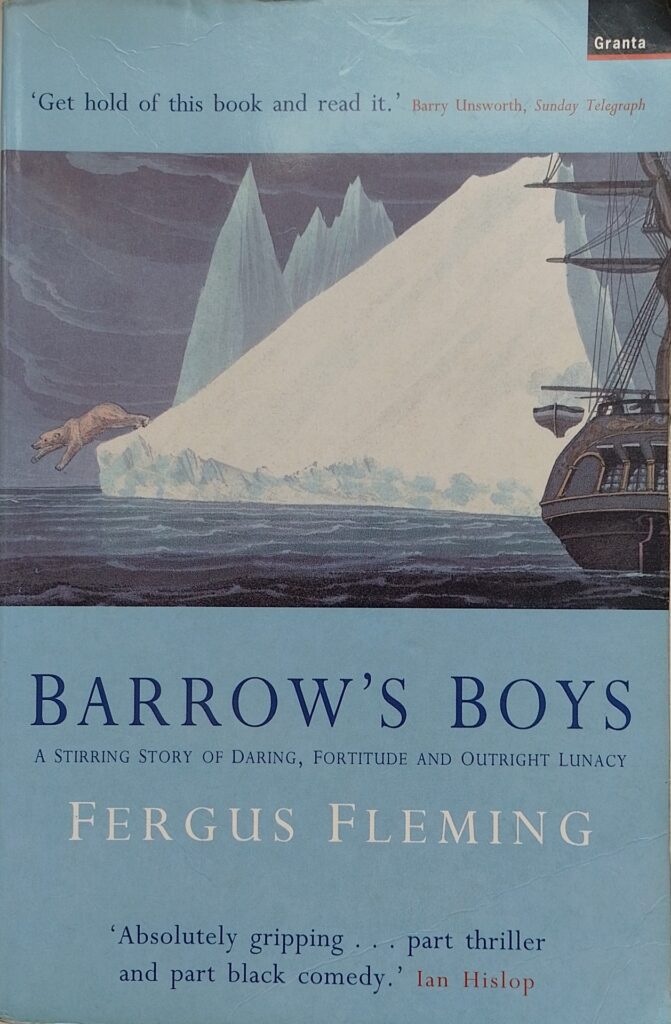First published 1998. Granta paperback, 1999, pp 503, c.150,000 words (main text).
Right towards the end, Fleming compares the UK’s exploration of the gaps in the map of the globe during the early nineteenth century, the topic of this book, to the USA’s space programme in the late twentieth century. In both cases, huge expenditures were made by the leading powers of the day to explore, with almost no prospect of economic return. In 1966, NASA’s expenditure was about 0.7% of USA GDP ($5.9 Bn out of $815 Bn). It is rather harder to estimate the expenditure on exploration by the UK because most of it was conducted through the navy. Perhaps the peak expenditure was £1m in a single year on equipping one or more major expeditions which would have been about 0.2% of UK GDP in 1820 (£530 M), and 0.1% by 1850 (£1,000 M). Both periods of exploration were driven in large part by great-power rivalry and egged on by the press, and ultimately, the public voters. Each was staffed by men with the ‘right-stuff’, mostly with military backgrounds if not actually still serving.
Fleming’s thesis is that the driving force behind the UK effort to fill in the blanks was one man, John Barrow, second secretary to the Admiralty Board. The Board, including the first secretary, were politicians, mostly unelected members of the House of Lords. Their role was to set naval strategy. The second secretary was a civil servant who managed the administration. Barrow was a very clever man, rising rapidly from a very modest background. He worked very hard, took a great interest in all around, and endeared himself to the great and the good. He served as second secretary from 1804 when he was forty to within three years of his death in 1848. Barrow’s initial tenure was dominated by the Napoleonic wars when the British navy grew rapidly in size. Once the wars were over in 1815 there were a lot of ships spare and officers furloughed on half pay. Many were agitating for jobs because otherwise promotion depended on dead-men’s-shoes. Barrow persuaded the Board to start putting together expeditions to explore and claim places for the British Empire before foreigners did. In particular, it was hoped there might be a passage around the north of the North American continent where ships could sail from the Atlantic to the Pacific. Other ‘gaps’ on the Europeans’ maps were central Africa, particularly the course of the Niger river, and Antarctica. Neither pole had been visited.
The book describes each of the principle expeditions launched by the UK in attempts to fill in these gaps. It is an extraordinary tale of heroic individuals, incompetence, penny-pinching, delusion and brutality. At least with the US space programme there was an attempt to match the men with the skills required for a role: a test pilot seems a good choice for an un-tested space vehicle; someone who is cool under pressure, with quick reactions and a good deal of intelligence. The British chose leaders who were well connected socially. When sending an expedition on an arctic voyage, one might have thought it best to send someone who had experience of the conditions, like a whaler captain who had fished in those waters. But no, they weren’t typically serving naval officers or friends to the upper classes. Some who were selected happened to be good leaders of men, some were great survivors; others were brutal and foolish, failing to take advice from experts. The cult of amateurism dominated then and plagues the UK to this day, and it had me frequently grinding my teeth.
There are a couple of occasions where attempts were made to use high-tech, but the adoption of steam-power was still unreliable and inefficient at the start of the period. By the end, its advantages of manoeuvrability in whatever wind conditions prevailed, and improvements in reliability made its adoption for Arctic and river exploration a more sensible choice.
Fleming summarises thus: ‘Barrow’s reign was finally over. It had started with one disaster – an expedition wiped out in Africa – and had wandered through tragedy and triumph to end with another – an expedition wiped out in the Arctic.’ [p422] and: ‘Almost everything about Barrow’s missions had been wrong – the orders, the ships, the supplies, the funding and the methods.’ [p423] It makes one want to weep. So many men, desperate for glory and material reward, sent off into the unknown to face suffering and death. Barrow was never brought to account for the disasters (he was only carrying out the Board’s orders, he might have claimed).
Fleming makes a good case for Barrow’s central role in initiating these voyages of discovery. He knew all the important people, and as well as his role as central to naval strategic planning, he was close to the leading scientists through his membership of the Royal Society, British Association and other groups.
As a read, this is hugely entertaining stuff. It could almost be a management textbook on how not to organise research. There are many wonderful (and some ghastly) characters who set off on these quests. There is much back-biting and jockeying for position amongst the masochists. There are also some lovely descriptions of Europeans first encountering remote and wild places.
Fleming writes very well, making for easy reading; it is fluid and literate. He gives character and atmosphere aplenty, and leads us through all the significant and interesting journeys, but doesn’t bog us down with laundry lists of unnecessary detail. The subtitle, ‘A stirring story of daring, fortitude and outright lunacy’, has it just about right.
The book includes an impressive bibliography and index, as well as maps showing the routes taken by the most significant voyages and a chronology of the major expeditions.
Encyclopedia.com biography of Fleming: https://www.encyclopedia.com/arts/educational-magazines/fleming-fergus-1959
Others’ reviews of the book: https://www.goodreads.com/book/show/878082.Barrow_s_Boys © William John Graham, April 2024

